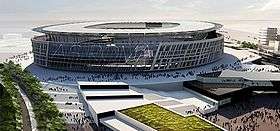Stadio della Roma
 A proposed design from March 2014 | |
| Location | Rome, Italy |
|---|---|
| Coordinates | 41°49′43.4″N 12°25′31.7″E / 41.828722°N 12.425472°ECoordinates: 41°49′43.4″N 12°25′31.7″E / 41.828722°N 12.425472°E |
| Owner | NEEP Roma Holding (parent company of A.S. Roma S.p.A.) |
| Capacity | 52,500 (expandable to 55,000) |
| Construction | |
| Construction cost | €300 million (2014 est.) |
| Architect | Dan Meis |
| Tenants | |
| A.S. Roma (planned) | |
| Website | |
| http://stadiodellaroma.com/ | |
Stadio della Roma (English: Stadium of Roma) is the temporary name for Serie A team A.S. Roma's planned stadium in the Tor di Valle neighborhood of Rome. A formal name for the stadium will be decided after naming rights are awarded, but is still uncertain over how long it will take to open the stadium.[1][2] The planned location is along the Tiber River and accessible via the main highway connecting the city with Leonardo da Vinci–Fiumicino Airport.[3] Seating capacity is planned for 52,500 spectators. The stadium is being designed by American architect Dan Meis, and is said to be inspired by the ancient Colosseum. Features of the stadium include luxury boxes, and a 14,000-seat section designated for the Ultras of the Curva Sud in the Stadio Olimpico, the 72,698-seat facility Roma currently shares with their crosstown rival, S.S. Lazio.[4]
The stadium and its facilities will replace the current Tor di Valle Racecourse, which is served by the Tor di Valle train stop on the Rome–Lido railway. Plans additionally call for service on Rome's Line B subway to be extended to the station, and on to Muratella, a train station on the FR1 railway that is across the river from the proposed development.[5] Besides the main stadium, plans call for additional venues for music, entertainment, shopping, and training facilities,[3] as well as bars, restaurants, and a Nike SuperStore.[6] The stadium, only the second in Italy to be privately owned and financed (Juventus Stadium is the first), is estimated to cost €300 million, but the total cost for all the facilities and venues, including infrastructure improvement, is close to €1 billion.[3]
In 2016 Goldman Sachs made a €30 million loan to Stadio TDV S.p.A., a wholly owned subsidiary of NEEP Roma Holding, for the pre-development cost of the stadium.[7]
On 2 February 2017, the Region of Lazio and the mayor of Rome rejected the proposal to build a new stadium,[8] however, the proposal was later approved on 24 February after final review of the stadium's design adjustments.[9]
In August 2017, the stadium hit another delay, with a new planning process beginning in September.[10] Roma subsequently renewed their lease with the Stadio Olimpico until 2020.[11]
References
- ↑ Scarsi, Selene (March 26, 2014). "Roma reveals new stadium plan". ESPN FC. Retrieved March 30, 2014.
- ↑ "Stadio della Roma still faces hurdles". Football Italia. 25 February 2017. Retrieved 25 February 2017.
- 1 2 3 Dinmore, Guy (March 26, 2014). "Boston fund manager plans new AS Roma stadium". The Financial Times. Retrieved March 30, 2014.
- ↑ Dampf, Andrew (March 26, 2014). "A modern Colosseum: Roma reveals new stadium plan". Associated Press. Retrieved March 30, 2014.
- ↑ "Roma, lo stadio ispirato al Colosseo: "Impianto da 52mila posti con fondi privati"". La Repubblica (in Italian). March 26, 2014. Retrieved March 31, 2014.
- ↑ De Martinis, Julian (March 27, 2014). "New stadium full of features Roma fans will love". ESPN FC. Retrieved March 30, 2014.
- ↑ "AS Roma Financial Press Release". A.S. Roma. 16 May 2016. Retrieved 17 May 2016.
- ↑ "Official: Stadio della Roma rejected". Football Italia. 2 February 2017. Retrieved 2 February 2017.
- ↑ "Mayor: Historic day for Roma". Football Italia. 24 February 2017. Retrieved 24 February 2017.
- ↑ "Official: Stadio della Roma delayed again". Football Italia. 9 August 2017.
- ↑ "Roma at Stadio Olimpico until 2020". Football Italia. 12 August 2017.